FOUR MONTHS IN A DAHABEEII.* Tuts is just one of
those books which ought to exist, but in manuscript only. To all who know the authoress and her friends it has, we doubt not, a faint interest, like that of an old letter, and it may save herself the trouble of interminable descrip- tions, but it has no attraction for the general public. It is a mere young lady's journal of an uneventful Nile voyage, trite in subject, and unredeemed by any novelty of view or power in the descriptions. Egypt, as the seat of the oldest and most excep- tional of civilizations, a land covered with relics of a past- away power and magnificence, the only morsel of Africa which has been the scene of visible progress, will always retain a high interest for the antiquary or the student. But Egypt as a place for descriptions of travel is almost exhausted ; the Nile entirely so. The river is as familiar as the Thames, and the traveller, unless he has something new to say, or a just confidence in his power of working up old material, might as well publish an itinerary of his journey from Calais to Rome, and expect to interest the world in that new development of human energy. Miss Carey cannot boast of either qualification. She set out for a four months' trip, in company apparently with two cousins, "Cousin Phil," an old and deaf gentlemen, whose courage she is never tired of admiring in print, and his invalid daughter. They travelled to the second cataract, by one of the great boats used by all travellers who can afford it, with an English footman and maidservant, and Mussulman dragoman, saw all the ordinary sights—and one extraordinary one, at least an Aline dance would have appeared so to an Englishwoman, if she had understood it—and made the ordinary proper young-
lady reflections. Of course, in such a journey, little in- cidents, quarrels with the boatmen, doubts about the drago- man, and difficulties with the people, were of constant • Four Months in a Dahabea. By Miss M. L. M. Cater. Booth.
occurrence, and they are recorded with the unfailing minute.
of a Livingstone or Barth. Very few of theta illustrate any thing at all, except the good-tempered kindliness of the writer, who, during a four mouths' Nile trip, has not a grievance to recollect or a grutnble to repeat; aad still fewer illustrate the country in which alone they would have appeared, even to a feminine mind, important enough for type. Whole pages are filled with meaningless little paragraphs like these :—"The high wind of Wadee Halfeh continued blowing against us, and impeding our progress very seriously. Front shore to shore we floated, or rowed alternately, making a few yards only at each turn, so that every stoae and tree might have been learnt by heart, and by night-fall we had only- reached the village of Serra." "So strong a wind was blowing fro:a the north-west, that having reached Sabooa we could mak3 no way at all, and were forced to stay there the whole day, sheltering on the windward side from the dense clouds of sand which covered the other vessel, whose owners had not yet paid their visit to the temple." All the trivial occurrences of the voyage, how cousin Phil sat in a mysteriously formed chair on deck, which once fell down, how -Mohammed the dragoman lost his temper, and refused the waitingmaid soap, how the rats nibbled everything, and how the crew tried to keep Christmas, are all described with a minute- ness which is, nevertheless, not picturesque. There is informa- tion, too, of course, but it is information so often repeated that it is as familiar to most people as the fact that the Pyramids exist in Egypt. Paragraphs like these,—and the book contains nothing more original,—have appeared in every work on the "Nile" published for the last hundred years, and read at the present day like bits from a cyclopfed;a :— " This was a day of great interest, and we thoroughly enjoyed the sight of the ‘Memnonium,' or palace of Memnon, one of the earliest kings of Egypt ; its fine pillars and capitals, and the hieroglyphic sub- jects sculptured on its walls; the huge broken statue in red granite of Remeses the Great, on which some hieroglyphics are cut, nearly two- inches deep, the cuts being as clean now as though they had but just been made. There lay the giant overturned, with his face to the ground. Then there were the two colossal statues in the midst of the extensive plain ; sitting still, and though much mutilated, and one of them almost faceless, seething grandly to review the surrounding deso- lation, as though they would be fain still to frame the thought, and to- exclaim, Monarchs of all we survey.' It is one of these statues which is said to have emitted a musical sound when struck by the rays of the_ rising sun ; and to this day when travellers approach, the Arab who' climbs to the top, in order to make the giant proportions of the statue more evident, strikes one of the uppermost stones, which emits a. metallic, though not otherwise musical sound."
The world, too, scarcely requires a new illustrated volume to tell it, as the authoress does at page 313, that the wonders of the great hall of columns at Karnak "are full of interest, and with the assistance of Murray's Hand-book may be traced out to a considerable extent." No one dreams of writing a book to tell us that there is a column in the Place Vendome, or that the Colos- seum is not visible till you are in Rome, or that St. Peter's has a dome ; and why should we tolerate pages of stuff like the following, simply because the scene happens to be laid in Egypt ?— " This flay was spent partly within partly without the temple of ' Thah,' the Lord of Truth. It is of the time of Remesea the Great, B.C. 1311, is hewn in the solid rock, knd must be seen by the light of the mashals.' Hundreds of bats rushed out from their hiding-places as the merry Arabs rushed in with their flaming brands. The figures on the Pillars of this temple, as well as on those of the portico, are badly exe- cuted. Compared to others of the same period, they are thick and dumpy in their proportions; but we could not help admiring the perse- verance which had accomplished a work of so much labour. There are single figures on all the pillars of the hall, and other groups of three, in high relief, on panels along one side, and on the wall of the adytum, in front of which stands the altar. Several chambers lie beyond, all in like manner covered with hieroglyphics, but so blackened by the smoke of the mashals' as to be now scarcely discernible,"
What sort of idea does that description leave on the mind ? Simply none at all, except that there exists somewhere on the Nile a temple of Thah, which is full of bats, and has certain Egyptian characteristics—,facts the world had registered morethan fifty years ago. What is now wanted is either a new and more minute description of the temple, or an account of its history, or a distinct picture of the effect it leaves on the mind of the passing traveller. A critic studying Millais's last work might as well write, "Here is a picture called the Eve of St. Agnes. It has a frame, and there is a girl and a big bed in it," and publish that as his addition to human knowledge.
It is not, however, necessary that information should always be new, if only it can be made to suggest new thoughts. There are writers like Miss Martineau, to whom the baldest and best known facts suggest thoughts so novel, illustrations so striking, that her wanderings over the best trodden routes have all the
intey .st of discovery. Miss Carey is not of that stamp, and we recJAly cannot feel interested, because at the sight of the Pyramids
our fancy revelled in the mine of antiquarian speculation which these venerele mounds presented," though the fancies themselves, if they had been recorded, might have been worth the hearing. Nor can we feel remarks like these, however suited to a home letter to evangelical friends, anything but redundant in type. The authoress had witnessed one of the most striking sights in the wor1c1,—a veritable bit of the "Arabian Nights,"—Cairo illumi- nated for a great religious festival. She devotes to it half a page, which is not descriptive, unless it be description to say that "such a picture is rarely seen in Europe," and apologiz es to herself and the world for admiring an absolutely original scene in this pathetic way: " But it was a Mahommedau festival after all ; in the open shops many sat upon their counters steadily reading por- tions of the K011till ; some few at least, of the obsequious crowd, true to their creed, uttered words of contempt at the Christian as the carriage drove along, and it was sad to think that all this joy and festivity was got up in honour of a false creed and false prophet." The creed may be false enough, and is certainly most imperfect, but Mahommedan festivals are in honour of the God whom the authoress als) worships, and not of Mahommed, who never claimed to be more than a teacher sent of God, and Would have rejected worship as the grossest idolatry. The authoress, however, naively confesses that she knows nothing of the creed she condemns, and is doubtful whether it is beneficial to know anything, for "Mr. M—n's dattabMi was at Assouan. He dined with 113 twice, and kindly lent us an English translation of the Koran to look at. Peilla.ps it was the curiosity natural to our sex that made Selina and me so anxious to look into it, for 'Cousin Phil' did not in the least care to see it ; he said 'he could not see why people should not be satisfied with the Bible.' And we were soon satisfied that no book in the world could be more full of vain repetitions and absurd stories than the Koran." Considering that the Koran is not only scripture but law, not only Moses but Blackstone, to the rulers of a fourth of the world, a glance at its contents might be justified on grounds a little higher than "the curiosity natural to our sex," and more especially as the Koran is one of the few Oriental books which is absolutely pure. We do not contest the right of an English lady to prefer to be ignorant if she pleases, but an authoress who never saw the Koran, whose idea of describing antiquities is to say that they may be made out with the assistance of Murray, and who has no capacity for description, should not publish 400 big pages about Mohammedans and the Nile.































 Previous page
Previous page